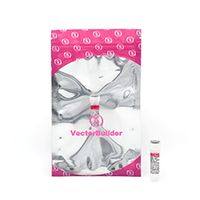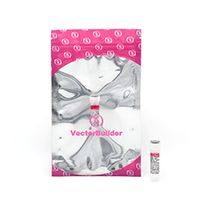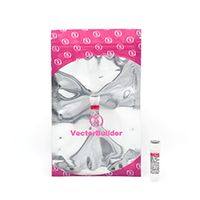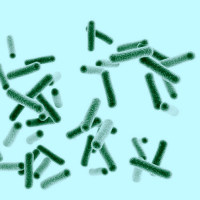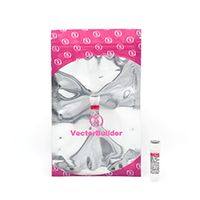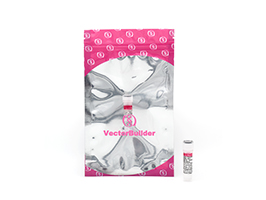
产品详情
文献和实验
相关推荐
提供商 :云舟生物科技(广州)股份有限公司
服务名称 :提供定制载体
此价格为VectorBuilder该类型产品标准服务价格,如需个性化定制,请询价。概述
基于Tol2 miR30的shRNA敲低载体系统是一种简单有效的方法,用于稳定敲低哺乳动物细胞中靶基因的表达。这种基于转座子的系统利用质粒转染(而不是病毒转导)将由一个或多个基于miR30的shRNA(shRNAmiR)靶向目标基因和用户选择的ORF组成的多顺反子表达盒永久整合到宿主细胞基因组中。shRNAmiR转录本由内源性细胞微RNA途径处理以产生成熟的shRNA,从而促进靶基因mRNA的降解。与合成siRNA的瞬时敲低相比,Tol2系统敲低的永久性具有几个主要优势(参见下面的优点部分)。
基于 Tol2 miR30 的 shRNA 敲低载体系统包含两种载体,均被设计为大肠杆菌质粒。一种载体,称为辅助质粒,编码转座酶。另一种载体称为转座子质粒,包含两个末端重复序列(TRs),包围要转座的区域,其中包括多顺反子shRNAmiR和ORF表达盒。当辅助质粒和转座子质粒共转染到靶细胞中时,辅助质粒产生的转座酶识别转座子上的两个TR,并将包括两个TR在内的侧翼区域插入宿主基因组。插入在插入部位序列方面没有任何明显的偏倚。这与具有特定目标共识位点的转座子系统不同。例如,piggyBac转座子通常在包含序列TTAA的位点插入。
与利用RNA聚合酶III启动子(如U6)的传统shRNA载体不同,基于miRNA的shRNA系统置于标准RNA聚合酶II启动子的控制之下。这允许使用组织特异性、诱导性或可变强度启动子,从而实现组成型 U6 启动子无法实现的各种实验应用。
相对于其他敲低载体系统,RNA聚合酶II启动子在基于miRNA的shRNA系统中有效转录长转录本的能力也提供了额外的优势。多个shRNAmiR可以转录为单个多顺子,其被加工成细胞内成熟的shRNA。这允许使用单个转录本敲低多个基因或靶向同一基因内的多个区域。因此,该载体可用于表达单个或多个shRNAmiR。其次,在该载体系统中,用户选择的蛋白质编码基因也位于与shRNAmiR相同的多顺子中。该ORF的表达可用于直接监测shRNA转录(如果使用标记ORF),或可用于需要ORF和shRNA共表达的其他目的。
Tol2 是 II 类转座子,这意味着它以剪切和粘贴的方式移动,从一个地方跳到另一个地方而不会留下副本。(相比之下,I 类转座子以复制和粘贴的方式移动。Tol2 通过剪切和粘贴机制作为单个副本集成。在每个插入位点,Tol2转座酶产生8 bp重复,导致基因组中每个转座子整合位点两侧相同的8 bp直接重复。
亮点
我们基于 Tol2 miR30 的 shRNA 敲低载体结合了用于敲低靶基因的优化微 RNA 系统。该载体与辅助质粒一起经过优化,可在大肠杆菌中实现高拷贝数复制、高效转染到广泛的靶细胞中,以及载体上携带的转基因的高水平表达。用户选择的启动子驱动包含用户选择的ORF和一个或多个具有优化的基于miR30的序列的shRNAmiR的多顺反子表达盒的表达,以介导有效的shRNA处理和靶基因敲低。
优势
发起人选择:与利用RNA聚合酶III启动子(如U6)的标准shRNA系统不同,基于miR30的shRNA可以被不同的RNA聚合酶II启动子转录。这也使得使用组织特异性或诱导性启动子成为可能。
多个 shRNA 共表达: 由于RNA聚合酶II有效地转录长RNA,因此多个shRNAmiR可以表达为来自单个启动子的多顺子。因此,该载体可用于表达单个或多个shRNAmiR。
记者ORF的共同表达: 用户选择的目的基因或报告基因ORF与shRNAmiR共表达,作为多顺子。这有助于直接监测shRNA转录。
永久集成和拆卸: 传统转染导致DNA几乎完全瞬时递送到宿主细胞中,因为DNA会随着时间的推移而丢失。这个问题在快速分裂的细胞中尤为突出。相反,由于转座子整合到宿主基因组中,用Tol2转座子质粒和辅助质粒转染哺乳动物细胞可以将转座子上携带的DNA序列永久递送到宿主细胞中。因此,使用该载体实现的靶基因敲低是稳定和永久的。对于许多实验目标来说,这可能是一个重要的优势。它允许对敲低表型进行长期分析。它有助于分离具有不同敲低水平和/或不同表型的克隆。当敲低载体携带荧光标记物(例如EGFP)时,它还允许具有不同转座子整合量的细胞(因此可能具有不同水平的敲低)通过具有不同荧光强度的流动分选细胞分离。
技术简单: 通过传统转染将质粒载体递送到细胞中在技术上很简单,并且比需要包装活病毒的基于病毒的载体容易得多。
安全: 传统转染没有通常与病毒载体相关的安全问题。
不足之处
有限的细胞类型范围: Tol2载体递送到细胞中依赖于转染。转染效率因细胞类型而异。非分裂细胞通常比分裂细胞更难转染,原代细胞通常比永生化细胞系更难转染。众所周知,一些重要的细胞类型,如神经元和胰β细胞,很难转染。这些问题限制了 Tol2 系统的使用。
载体关键元件
单个 miR30-shRNA Tol2 shRNA 敲低载体
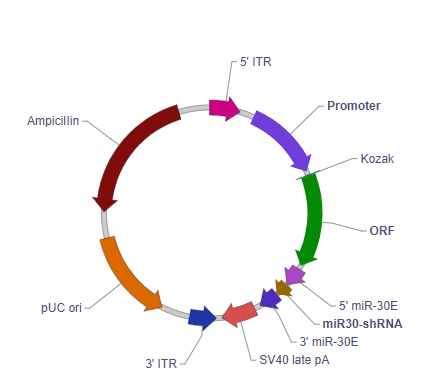
5' ITR: Tol2 5' terminal repeat. When a DNA sequence is flanked by two ITRs, the Tol2 transposase can recognize them, and insert the flanked region including the two ITRs into the host genome.
Promoter: Drives transcription of the downstream ORF and shRNAmiR polycistron. This is an RNA polymerase II promoter, rather than an RNA polymerase III promoter such as U6.
Kozak: Kozak consensus sequence. It is placed in front of the start codon of the ORF of interest because it is believed to facilitate translation initiation in eukaryotes.
ORF: The open reading frame of your gene of interest or reporter gene is placed here. This can be used to monitor shRNA expression.
5' miR-30E: An optimized version of the human miR30 5’ context sequence. Facilitates maturation and processing of the shRNA and separation from the tandemly transcribed ORF and other shRNAs.
3' miR-30E: An optimized version of the human miR30 3’ context sequence. Facilitates maturation and processing of the shRNA and separation from the tandemly transcribed ORF and other shRNAs.
miR30-shRNA: This sequence is derived from your target sequence and is transcribed to form the stem portion of the “hairpin” structure of the shRNA.
SV40 late pA: Simian virus 40 late polyadenylation signal. It facilitates transcriptional termination and polyadenylation of the upstream ORF and shRNAmiR polycistron.
3' ITR: 3' inverted terminal repeat.
Ampicillin: Ampicillin resistance gene. It allows the plasmid to be maintained by ampicillin selection in E. coli.
pUC ori: pUC origin of replication. Plasmids carrying this origin exist in high copy numbers in E. coli.
Multiple miR30-shRNA Tol2 shRNA knockdown vector
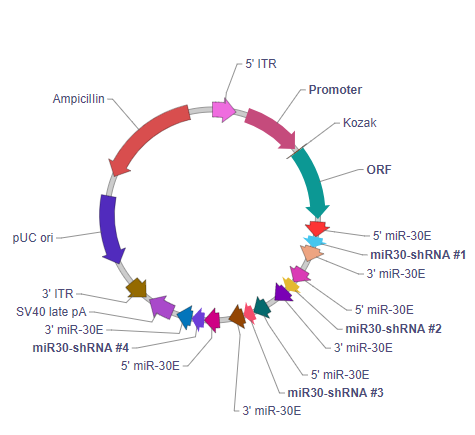
5' ITR: Tol2 5' terminal repeat. When a DNA sequence is flanked by two ITRs, the Tol2 transposase can recognize them, and insert the flanked region including the two ITRs into the host genome.
Promoter: Drives transcription of the downstream ORF and shRNAmiR polycistron. This is an RNA polymerase II promoter, rather than an RNA polymerase III promoter such as U6.
Kozak: Kozak consensus sequence. It is placed in front of the start codon of the ORF of interest because it is believed to facilitate translation initiation in eukaryotes.
ORF: The open reading frame of your gene of interest or reporter gene is placed here. This can be used to monitor shRNA expression.
5' miR-30E: An optimized version of the human miR30 5’ context sequence. Facilitates maturation and processing of the shRNA and separation from the tandemly transcribed ORF and other shRNAs.
3' miR-30E: An optimized version of the human miR30 3’ context sequence. Facilitates maturation and processing of the shRNA and separation from the tandemly transcribed ORF and other shRNAs.
miR30-shRNA #1: This sequence is derived from your first target sequence and is transcribed to form the stem portion of the “hairpin” structure of the shRNA.
miR30-shRNA #2: This sequence is derived from your second target sequence and is transcribed to form the stem portion of the “hairpin” structure of the shRNA.
miR30-shRNA #3: This sequence is derived from your third target sequence and is transcribed to form the stem portion of the “hairpin” structure of the shRNA.
miR30-shRNA #4: This sequence is derived from your fourth target sequence and is transcribed to form the stem portion of the “hairpin” structure of the shRNA.
SV40 late pA: Simian virus 40 late polyadenylation signal. It facilitates transcriptional termination and polyadenylation of the upstream ORF and shRNAmiR polycistron.
3' ITR: 3' inverted terminal repeat.
Ampicillin: Ampicillin resistance gene. It allows the plasmid to be maintained by ampicillin selection in E. coli.
pUC ori: pUC origin of replication. Plasmids carrying this origin exist in high copy numbers in E. coli.

云舟生物科技(广州)股份有限公司
品牌商实名认证
金牌会员
入驻年限:6年

